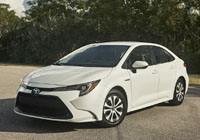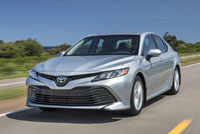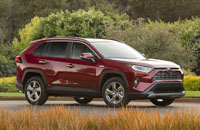
Plenty of carmakers build hybrid vehicles, but none has been as successful at partial electrification as Toyota. Of course, it had a head start, creating the entire sector in 1997 with the launch of its original Prius. Now, 23 years later, Toyota has filled the world with more than 15 million hybrid vehicles, while accounting for 80 percent of all hybrid sales globally.
An updated version of that first-generation Prius arrived in Canada for 2000, and now that model is well into its fourth generation and an automotive icon. No other hybrid electric car has sold anywhere near as well as the Prius, plus Toyota has a number of other hybrids to its credit as well.

While the full-size Prius v (for volume) was discontinued in 2017 and subcompact Prius c was cancelled last year, the plug-in Prius Prime is pointing Toyota in a more fully electrified direction. That model, which gets unique styling and the ability to drive at regular city and even highway speeds under full electric power, will be joined by a plug-in RAV4 Prime for 2021, which should be even more popular.
Speaking of popular, Toyota added a Corolla Hybrid to the gasoline-electric fleet for 2020, this model now going head-to-head against Honda’s Insight, which is little more than a restyled Civic hybrid, whereas the Camry Hybrid remains popular with those who require a bigger sedan.

Toyota doesn’t offer its full-size Avalon Hybrid in Canada, but the aforementioned RAV4 Prime currently comes as a RAV4 Hybrid too, and its popularity will make sure no one in Canada is lamenting the loss of Toyota’s big flagship four-door sedan. Another SUV worth considering is the near-full-size Highlander Hybrid that’s oddly the only mid-size SUV available in the mainstream sector with a hybrid powertrain. Last but hardly least, Toyota offers fleet buyers one of the only hydrogen fuel cell-powered vehicles available, the one-of-a-kind Mirai taking the hybrid concept into a totally new direction.

Notably, a considerable number of the 15 million hybrids sold under Toyota’s umbrella wore the Lexus badge, the Japanese automaker’s luxury division adding seven additional gasoline-electric models to the namesake brand’s eight. Starting from the least expensive is the entry-level UX 250h subcompact crossover, which is followed by the NX 300h compact crossover, the ES 300h mid-size luxury sedan, the RX 450h mid-size crossover SUV, the longer three-row RX 450h L, the LC 500h personal sport-luxury coupe, and lastly the Lexus LS 500h full-size sedan flagship (gone are the HS 250h, CT 200h and GS 450h).

If you think that 15 hybrid models from two brands is an impressive accomplishment, considering for a moment that Toyota and Lexus sell 44 unique hybrid vehicles outside of Canada, while hybrids combined for 52 percent of Toyota’s overall sales volume in Europe last year.
So what does the future hold? Toyota plans to increase hybrid integration into more models moving forward, while continuing to develop its hydrogen fuel cell and full electric programs too. Toyota Executive Vice President Shigeki Terashi announced in June 2019 that half of the carmaker’s global sales would be electrified by 2025. Expect a combination of hybrid (HEV), plug-in hybrid (PHEV) and fully electric (BEV) vehicles, and with that latter category in mind, Terashi pointed out that an entirely new line of full electrics would be designed for international consumption.
Story credit: Trevor Hofmann
Photo credits: Toyota
